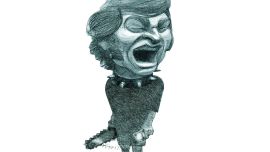A new investigation has reconstructed the infiltration of a second Federal Police intelligence agent into the Madres de Plaza de Mayo human rights group during Argentina’s last military dictatorship (1976-1983).
Until now the only such known case was that of the “Ángel Rubio de la Muerte,” cashiered naval officer Alfredo Astiz. He famously pretended to be related to missing people in order to spy on those going to the Church of the Holy Cross, where a naval taskforce kidnapped a dozen people on December 8 to 10, 1977.
Among those taken were co-founder of the Madres Azucena Villaflor and two French nuns. The information provided by Astiz, who had gained the confidence of the group, was crucial to the success of the abduction plan.
Last weekend, a new investigation by Página/12 journalist and former Buenos Aires Herald staffer Luciana Bertoia revealed the unknown history of a Federal Police agent with the code name of ‘Isabelita.’
According to Bertoia, a contributor to the Times, the woman known as Isabelita employed the same modus operandi as Astiz, infiltrating the families of the missing in order to anticipate their movements and assist with the kidnapping of what the military junta described as "subversives."
‘A Squad’
The existence of Isabelita can be traced back to 1981, when a former government spy Luis Alberto Martínez mentioned her to the International Federation for Human Rights as a participant in the infamous Holy Cross kidnappings. Martínez confirmed both her role as an infiltrator into the Madres de Plaza de Mayo and her Federal Police membership.
According to a document signed by that force’s Intelligence chief, Juan Andrés Fonte, Isabelita served in ‘A-Squad’ as an infiltrator into the grouping identified by junta as "MADRES DE TERRORISTAS." After being denounced by ex-agent Martínez, Isabelita’s superiors then requested her transfer to Mar del Plata as a cover-up.
Martínez explained at the time that the woman established her credentials by lying about the disappearance of a supposed brother, which enabled her to attend the meetings of those searching for their loved ones. For the intelligence and security forces of those times, the detailed follow-up of the families of the detained and missing was crucial.
Between 1976 and 1979, Isabelita served in various Federal Police agencies, including the Department of Subversive Affairs, as well as following a specialised course in intelligence and even enrolling as a philosophy and literature student at the University of Buenos Aires.
The agent continued with these activities beyond the dictatorship years in power. In 1983 she formed part of the Department for the Protection of Constitutional Order, spying on the Todos por la Patria movement (who later attacked the La Tablada Army barracks in early 1989).
According to Bertoia’s investigation, she joined the Federal Intelligence School in 1997, thus continuing well beyond her past as an infiltrator into the organisations of the victims of state terrorism. In 2003, when Néstor Kirchner became president, she finally decided to call it a day, it is claimed.
‘Open the archives’
Officials and NGOs reacted strongly to the news, with the government’s own Human Rights Secretariat calling for a wider investigation into the Página/12 report.
"It is important to deepen this investigation and find out more about the participation of this Federal Police spy embedded in the Madres de Plaza de Mayo in the context of the last civic-military dictatorship and her form of procedure in later years,” Human Rights Secretary Horacio Pietragalla Corti told Perfil. “This case also demonstrates that the human rights movement was right when it denounced that impunity permitted the continuity of the practices of the dictatorship in democracy.”
Some experts called for secret archives to be opened up.
“What this contributes is more information and evidence for the idea that it is necessary to open up the secret archives of the Federal Police and complete the analysis of what was its role during the dictatorship and afterwards with the recovery of democracy,” said CELS (Centro de Estudios Legales y Sociales) director Paula Litvachky.
“It’s new information in relation to the particular case of this woman, allowing us to warn that there were more people in this kind of role,” she added.
Consulted as to why classified archives had not been opened previously, Litvachky said that digging up information about the functioning of the Federal Police during the dictatorship and subsequently has been difficult.
“That’s why we say that the court investigations must advance to see who was responsible for the human rights violations during the dictatorship, such as the Balbuena case, and the possibility of the government actively declassifying in order to understand how things worked in those times, who intervened and to get to know the rules by which they worked,” she said.
The CELS director was referring to Américo Balbuena, a former Federal Police agent who pretended to be a journalist for the Agencia Walsh in order to compile information about social organisation, trade union, human rights and political leaders.
Human Rights Secretariat demands probe
The Human Rights Secretariat has presented a request to Federal Judge Ariel Lijo, who is in charge of the ESMA Navy Mechanics School mega-case, that he open up the Federal Police’s secret archives.
Reacting to the report about ‘Isabelita,’ the department headed by Horacio Pietragalla Corti asked for an in-depth investigation of the possible participation of an intelligence agent known as ‘Isabelita’ in the kidnap of Mothers of Plaza de Mayo, the relatives of missing people and the French nuns Alice Domon and Léonie Duquet in December, 1977.
This woman had already been investigated within the ESMA mega-case, according to reports, but this aspect had been shelved because it had not been possible to prove her participation in the operations attributed to her. The Página/12 investigation points out that there was a women’s hostel at Viamonte 1596 where the agent had resided together with the French nuns.
“The writ required that an order be sent to the AFI (Agencia Federal de Inteligencia) intelligence agency to go through the documentation produced by the intelligence services during the civic-military dictatorship to ask for all the information relating to the investigated woman,” detailed the communiqué of the Secretariat.
They further analyse “making a presentation to federal judge Daniel Rafecas, who is in charge of the First Army Corps case, to investigate her participation in crimes against humanity at the clandestine detention centre “Coordinación Federal,” as the Superintendencia de Seguridad Federal was then known.”
– TIMES/PERFIL






















Comments